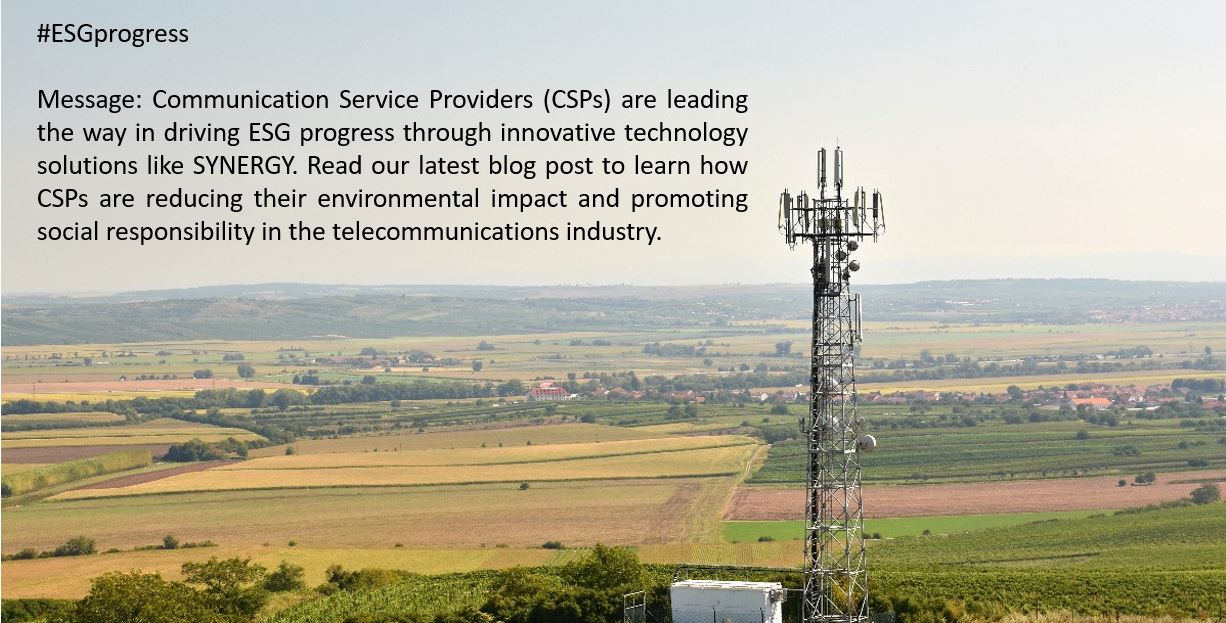Abstract: This article explores the innovative ways that Communication Service Providers (CSPs) are using technology to drive Environmental, Social, and Governance (ESG) progress. CSPs are leveraging digital technologies and autonomous operations to reduce their environmental impact, promote social responsibility, and support sustainable business practices. The article examines how CSPs are adopting green technologies like renewable energy, smart buildings, and carbon capture and storage to reduce their carbon footprint and investing in digital education and digital inclusion programs to promote social equity. Additionally, CSPs are using cloud computing and virtualization technologies to reduce energy consumption and circular economy initiatives to reduce waste and promote the reuse and recycling of materials. The article concludes by emphasizing the importance of technology in driving ESG progress and providing specific examples, including SYNERGY’s use case, of CSPs successfully leveraging technology to achieve their ESG goals.
Introduction
The telecommunications industry is a crucial part of the global economy, connecting people and businesses around the world. However, this growth comes with environmental and social challenges, such as carbon emissions, digital exclusion, and waste management. Communication Service Providers (CSPs) are increasingly aware of their responsibility to address these challenges and are leveraging digital technologies and autonomous operations to drive ESG progress. This post will examine some of the innovative ways that CSPs are using technology to reduce their environmental impact, promote social responsibility, and support sustainable business practices. From renewable energy sources to digital education programs, CSPs are demonstrating their commitment to a more sustainable and equitable future.
Reducing Environmental Impact
Reducing the environmental impact of CSPs has become a critical issue in recent years. To address this challenge, CSPs are increasingly adopting green technologies that not only reduce their carbon footprint but also help them to achieve their sustainability goals. One of the most common approaches to reducing environmental impact is the use of renewable energy sources such as solar and wind power. CSPs are installing solar panels and wind turbines to power their networks, data centers, and offices, which not only helps to reduce their reliance on fossil fuels but also lowers their electricity bills. For example, Vodafone has implemented wind power to supply energy to its data centers in India, while Orange is building solar farms to power its operations in Africa.
CSPs are also investing in smart buildings that are designed to optimize energy use and reduce waste. Smart building technologies like energy-efficient lighting, heating, and cooling systems are being installed in CSPs’ offices and data centers. These technologies are helping to reduce energy consumption and greenhouse gas emissions, while also improving the comfort and productivity of employees. For instance, Vodafone has implemented smart building technologies to reduce energy consumption by 35% in its Madrid office.
Promoting Social Responsibility
CSPs are taking steps to promote social responsibility through their investments in digital education and inclusion programs. These programs aim to bridge the digital divide and promote social equity by providing access to digital technologies and services to underprivileged communities and individuals. For example, Vodafone’s “What Will You Be?” program is providing digital education to children in underprivileged communities, inspiring them to pursue careers in STEM fields. Similarly, Telenor is partnering with governments and NGOs to provide affordable mobile internet services to rural communities in Asia and Africa, enabling greater access to information and opportunities. By investing in digital education and inclusion programs, CSPs are helping to create a more equitable and connected world.
Supporting Sustainable Business Practices
CSPs are using cloud computing and virtualization technologies to reduce their energy consumption and carbon footprint. Cloud computing and virtualization technologies enable CSPs to consolidate their network and data center infrastructure, thereby reducing their energy consumption and carbon emissions. Telefonica is using cloud computing and virtualization technologies to reduce its energy consumption. The company has consolidated its data center infrastructure and is using virtualization technologies to reduce the number of physical servers needed to support its network. CSPs are also investing in circular economy initiatives aimed at reducing waste and promoting the reuse and recycling of materials. BT is investing in circular economy initiatives that reduce waste and promote the reuse and recycling of materials.
An example #1 CSPs leveraging technology to drive ESG progress is the SYNERGY solution by TTG International. The solution uses AI, machine learning, and big data analytics to optimize Cell-site Energy Management, reduce energy consumption, and minimize carbon emissions. Turkcell, a leading CSP in Turkey, has successfully implemented the SYNERGY solution to reduce its energy consumption and carbon emissions while improving network performance and customer experience. By integrating such technologies, CSPs can create a positive impact on the environment, society, and the economy, differentiate themselves from competitors and build stronger relationships with customers, investors, and other stakeholders. The SYNERGY solution is an excellent example of how CSPs can leverage technology to drive ESG progress, as it helps CSPs to reduce their environmental impact while also improving operational efficiency.
An example #2 of the SYNERGY solution’s use case is remote battery testing, which helps reduce operational expenditures and capital expenditures by extending battery life cycles. This is achieved through the use of machine learning algorithms that can predict battery health and detect issues before they become critical, as well as AI-predicted battery real charging time of the cell-sites. By extending the battery life cycle, the SYNERGY solution helps to reduce the amount of scrap battery in nature, leading to a positive environmental impact. One of the measurable KPIs of the SYNERGY solution is the reduction of site-visit time and fuel consumption, as fewer site visits are needed for battery testing. Additionally, SYNERGY contributes to the Green Network Sustainability KPIs by reducing energy consumption and carbon emissions.
Another benefit of the SYNERGY solution is an increase in brand reputation, as CSPs that implement the solution can differentiate themselves from their competitors and demonstrate their commitment to sustainable practices. Overall, the SYNERGY solution is a powerful tool for CSPs looking to reduce costs, increase efficiency, and promote sustainability in their operations. By integrating such technologies, CSPs can create a positive impact on the environment, society, and the economy, while also building stronger relationships with customers, investors, and other stakeholders.
Conclusion
CSPs play a critical role in promoting sustainable development and addressing global ESG challenges. By embracing innovative technologies and sustainable business practices, CSPs contribute to a greener and more equitable future while creating value for themselves and their stakeholders. CSPs use drones and satellite imaging to monitor and manage their networks, which reduces the need for manual inspections and helps identify potential environmental risks. CSPs also develop sustainable packaging solutions to reduce waste and use blockchain technology to increase supply chain transparency and accountability.
Conclusion
CSPs play a critical role in promoting sustainable development and addressing global ESG challenges. By embracing innovative technologies and sustainable business practices, CSPs contribute to a greener and more equitable future while creating value for themselves and their stakeholders. CSPs use drones and satellite imaging to monitor and manage their networks, which reduces the need for manual inspections and helps identify potential environmental risks. CSPs also develop sustainable packaging solutions to reduce waste and use blockchain technology to increase supply chain transparency and accountability.
In conclusion, the telecommunication industry is evolving, and CSPs are using digital technologies and autonomous operations to reduce their environmental impact, promote social responsibility, and support sustainable business practices. By adopting innovative technologies like renewable energy, smart buildings, and the SYNERGY solution, CSPs are demonstrating their commitment to a more sustainable and equitable future.



